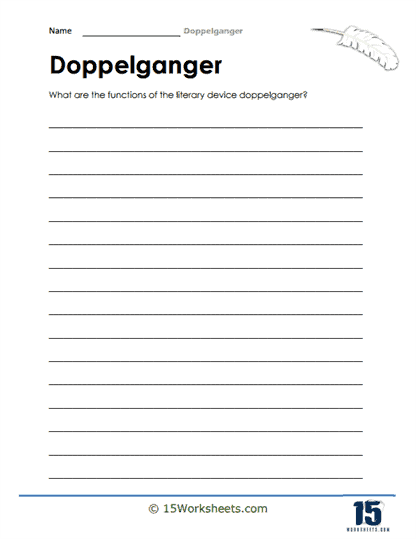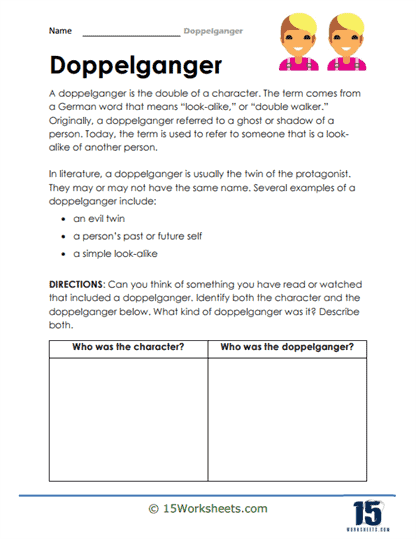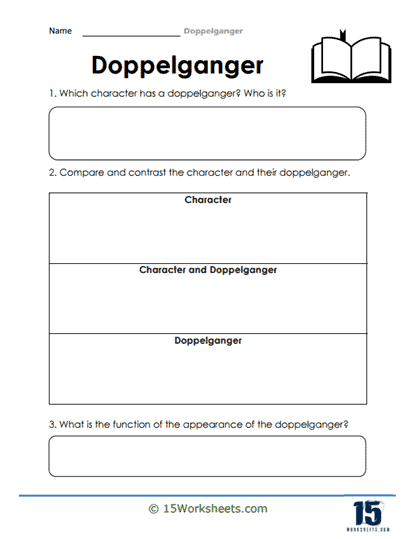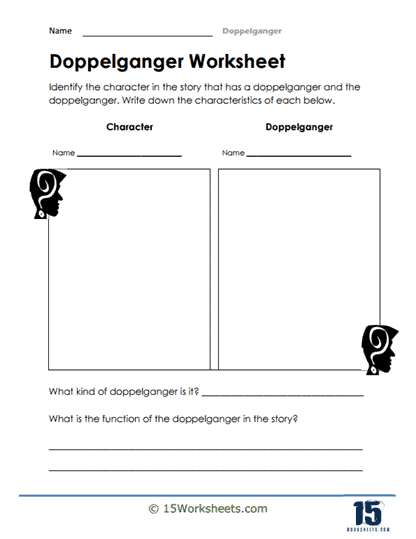Doppelganger Worksheets
All About These 15 Worksheets
The concept of doppelgangers, or look-alike individuals, has fascinated humans for centuries. It’s a theme that spans literature, folklore, and even pop culture. The idea that there might be someone out there who looks exactly like you can be both intriguing and eerie. Exploring doppelgangers not only taps into our innate curiosity but also offers valuable opportunities for learning and self-reflection.
A doppelganger is a term from German that means “double goer” and is a character in literature that serves as a kind of mirror or twin of another character. This device is used to explore different aspects of the main character’s personality, create conflict, or provide a foil – a character that contrasts with another to highlight their traits.
For instance, in Robert Louis Stevenson’s “Dr. Jekyll and Mr. Hyde,” Dr. Jekyll is a respectable scientist, while his doppelganger, Mr. Hyde, is a violent and cruel man. Here, the doppelganger is used to explore the dual nature of humanity.
These worksheets contain exercises aimed at helping students identify and understand the use of this device in different literary works. Here are some types of exercises you might expect to see on these worksheets:
Definition and Examples – This section provides a clear definition of a doppelganger, along with some examples from popular literature. This would serve as an introduction and foundation for the rest of the worksheet.
Identification Exercises – Here, students will be given passages or summaries of books, plays, or stories and asked to identify the doppelganger (if one exists) and explain how they function within the narrative.
Comparison and Contrast – In these exercises, students are asked to compare and contrast two characters in a story to determine if they are doppelgangers of each other. This could involve noting similarities and differences in their character traits, actions, and roles in the story.
Creative Writing Prompts – These worksheets include a section where students are asked to create their own characters who are doppelgangers. This would allow them to apply their understanding of the concept in a creative way.
Analysis Questions – This section would ask more in-depth questions, such as “What does the doppelganger reveal about the main character?” or “How does the presence of the doppelganger affect the story’s outcome?” This would help students think critically about the use and implications of this literary device.
What is the Literary Device of Doppelganger?
“Doppelganger,” a term derived from the German language, literally translates to “double goer”. In literature, this device refers to a character who mirrors or parallels another character in some significant way. The doppelganger could be an identical look-alike or twin, or it could be a character with personality traits that mirror or invert those of another character. By using this literary device, authors can delve into the complexity of the human psyche, explore themes of self and identity, emphasize or highlight character traits, or build dramatic tension and conflict.
The main defining feature of a doppelganger is its profound similarity to, or replication of, another character. But this replication often comes with a twist. The doppelganger might represent a side of a character that they’d rather keep hidden, or they might highlight a conflict within a character’s personality. They might also personify a character’s fears, desires, or moral failings. This often creates an intriguing paradox – the doppelganger is simultaneously the same as another character, and yet strikingly different.
Examples of the Use of Doppelgangers in Literature
Example 1: Dr. Jekyll and Mr. Hyde in “The Strange Case of Dr. Jekyll and Mr. Hyde” by Robert Louis Stevenson
In Stevenson’s iconic novella, Dr. Henry Jekyll, a reputable scientist, creates a potion that transforms him into Edward Hyde, a hideous and morally repugnant man. Here, Hyde is Jekyll’s doppelganger – a physical and behavioral manifestation of the darker aspects of Jekyll’s personality that he tries to repress.
The doppelganger in this instance serves to emphasize the dual nature of humanity – the constant struggle between our socially acceptable selves and our darker, more primitive instincts. Stevenson uses the doppelganger to pose philosophical questions about morality, responsibility, and the nature of selfhood. The stark contrast between the respectable Dr. Jekyll and the monstrous Mr. Hyde underscores the powerful, often dangerous, forces that can lurk beneath the surface of an individual.
Example 2: William Wilson in “William Wilson” by Edgar Allan Poe
In this short story, the protagonist, named William Wilson, encounters another boy at school who shares his name, his birth date, and his appearance. This other William Wilson often mimics the protagonist’s behavior and opposes his questionable decisions, much to the annoyance of the main character.
Here, the doppelganger serves as a personification of the protagonist’s conscience, reflecting his moral compass and highlighting his ethical transgressions. The protagonist’s decision to murder his doppelganger symbolizes his rejection of moral restraint, a decision that leads to his ultimate demise. Through the doppelganger, Poe explores themes of guilt, morality, and the duality of human nature.
Example 3: The Ghost of Christmas Yet to Come in “A Christmas Carol” by Charles Dickens
In this classic novella, the Ghost of Christmas Yet to Come acts as a doppelganger for the miserly Ebenezer Scrooge. The ghost, a silent specter that shows Scrooge a grim vision of his lonely death, represents what Scrooge will become if he continues on his current path.
While not a doppelganger in the traditional sense of physical resemblance, the ghost mirrors Scrooge’s potential future and reflects the cold, uncaring person Scrooge has become. The encounter with this spectral doppelganger forces Scrooge to confront the consequences of his selfish ways, leading to his eventual redemption. In this way, Dickens uses the doppelganger to convey a moral message about the importance of empathy and generosity.
Importance of Studying Doppelgangers For Students
Understanding doppelgangers goes beyond mere curiosity; it has several important implications for students’ personal growth and education:
- Cultural Awareness: Doppelganger legends and beliefs are prevalent in various cultures around the world. Exploring these myths can help students develop a deeper understanding of different cultures, their beliefs, and their perspectives on identity and destiny.
- Literary Analysis: Doppelgangers are a recurring motif in literature, from classic works like Edgar Allan Poe’s “William Wilson” to modern stories like Dostoevsky’s “The Double.” Analyzing these texts can sharpen students’ literary analysis skills and enhance their appreciation of literary techniques.
- Psychological Exploration: The concept of doppelgangers can spark discussions about identity, self-perception, and the human psyche. It invites students to reflect on their own sense of self and how it may be influenced by external factors.
- Critical Thinking: Investigating doppelgangers requires critical thinking skills, as students must analyze evidence, make connections, and draw conclusions about the existence of look-alikes. This encourages a higher level of cognitive engagement.
- Creative Writing: Doppelgangers offer a fertile ground for creative writing. Students can explore various scenarios, from humorous to eerie, and create their own doppelganger-themed stories, fostering creativity and imagination.
Exploring the world of doppelgangers through this collection of 15 engaging worksheets offers students an opportunity to not only satisfy their curiosity but also develop essential skills in cultural awareness, literary analysis, critical thinking, psychology, and creative expression.
By delving into this intriguing topic, students will not only enhance their academic abilities but also gain valuable insights into their own identities and the world around them. The benefits of studying doppelgangers extend beyond the classroom, fostering a deeper understanding of human nature and the diverse cultures that shape our world.















